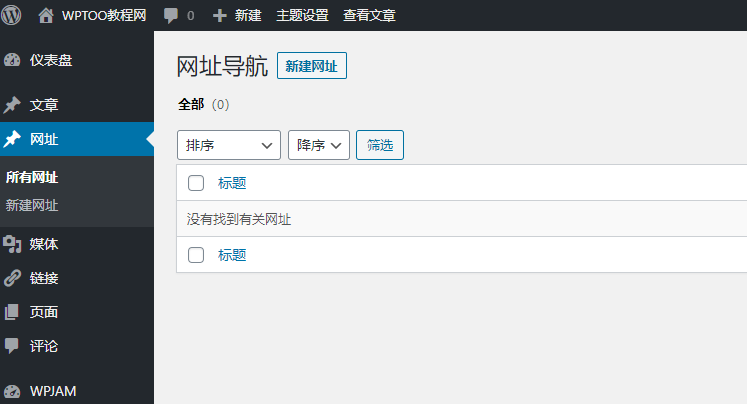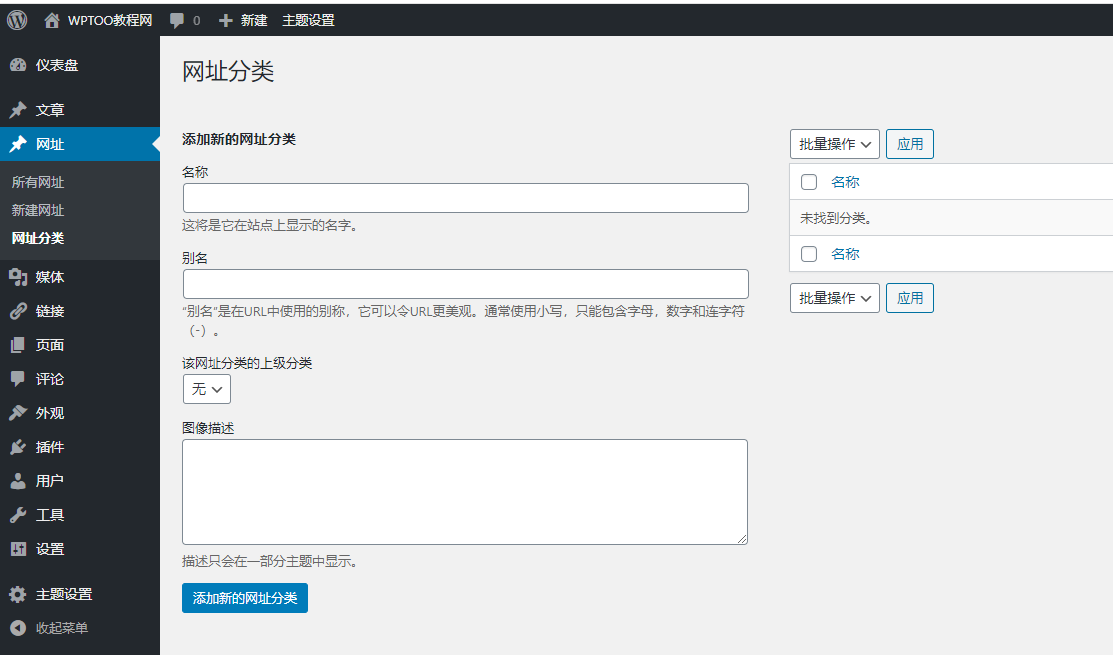WordPress PostType(自定义文章类型)功能介绍
创建一个新的 Post Type 需要使用 register_post_type 函数注,在你主题的 functions.php 文件下调用该函数:
register_post_type( $post_type, $args );
//$post_type 参数就是你自定义 Post Type 的名称。
function my_custom_post_product() {
$args = array();
register_post_type( \\\\\\\'product\\\\\\\', $args );
}
add_action( \\\\\\\'init\\\\\\\', \\\\\\\'my_custom_post_product\\\\\\\' );
参数很多,为了写教程方便,只列出比较常用的参数,大体结构如下:
function my_custom_post_site() {
$labels = array(
\\\\\\\'name\\\\\\\' => _x( \\\\\\\'网址导航\\\\\\\', \\\\\\\'post type 名称\\\\\\\' ),
\\\\\\\'singular_name\\\\\\\' => _x( \\\\\\\'网址\\\\\\\', \\\\\\\'post type 单个 item 时的名称,因为英文有复数\\\\\\\' ),
\\\\\\\'add_new\\\\\\\' => _x( \\\\\\\'新建网址\\\\\\\', \\\\\\\'添加新内容的链接名称\\\\\\\' ),
\\\\\\\'add_new_item\\\\\\\' => __( \\\\\\\'新建网址\\\\\\\' ),
\\\\\\\'edit_item\\\\\\\' => __( \\\\\\\'编辑网址\\\\\\\' ),
\\\\\\\'new_item\\\\\\\' => __( \\\\\\\'新网址\\\\\\\' ),
\\\\\\\'all_items\\\\\\\' => __( \\\\\\\'所有网址\\\\\\\' ),
\\\\\\\'view_item\\\\\\\' => __( \\\\\\\'查看网址\\\\\\\' ),
\\\\\\\'search_items\\\\\\\' => __( \\\\\\\'搜索网址\\\\\\\' ),
\\\\\\\'not_found\\\\\\\' => __( \\\\\\\'没有找到有关网址\\\\\\\' ),
\\\\\\\'not_found_in_trash\\\\\\\' => __( \\\\\\\'回收站里面没有相关网址\\\\\\\' ),
\\\\\\\'parent_item_colon\\\\\\\' => \\\\\\\'\\\\\\\',
\\\\\\\'menu_name\\\\\\\' => \\\\\\\'网址\\\\\\\'
);
$args = array(
\\\\\\\'labels\\\\\\\' => $labels,
\\\\\\\'description\\\\\\\' => \\\\\\\'网址信息\\\\\\\',
\\\\\\\'public\\\\\\\' => true,
\\\\\\\'menu_position\\\\\\\' => 5,
\\\\\\\'supports\\\\\\\' => array( \\\\\\\'title\\\\\\\', \\\\\\\'editor\\\\\\\', \\\\\\\'thumbnail\\\\\\\', \\\\\\\'excerpt\\\\\\\', \\\\\\\'comments\\\\\\\' ),
\\\\\\\'has_archive\\\\\\\' => true
);
register_post_type( \\\\\\\'site\\\\\\\', $args );
}
add_action( \\\\\\\'init\\\\\\\', \\\\\\\'my_custom_post_site\\\\\\\' );
将上面代码加到主题 functions.php 的最下面,进入后台你会发现多出了 site 选项,这样表示注册成功:

这时候我们可以新建 site发表一篇电影类型的文章了。但是这样与文章类型基本相同,我们需要更多的自定义来完善我们的 site类型。
添加分类功能需要使用函数 register_taxonomy,使用方法也很简单,跟注册 Post Type 函数类似,只不过多了一个参数用来指定对应的 Post Type :
register_taxonomy( $taxonomy, $object_type, $args );
就本例而言,可以配置如下常用参数:
function my_taxonomies_site() {
$labels = array(
\\\\\\\'name\\\\\\\' => _x( \\\\\\\'网址分类\\\\\\\', \\\\\\\'taxonomy 名称\\\\\\\' ),
\\\\\\\'singular_name\\\\\\\' => _x( \\\\\\\'网址分类\\\\\\\', \\\\\\\'taxonomy 单数名称\\\\\\\' ),
\\\\\\\'search_items\\\\\\\' => __( \\\\\\\'搜索网址分类\\\\\\\' ),
\\\\\\\'all_items\\\\\\\' => __( \\\\\\\'所有网址分类\\\\\\\' ),
\\\\\\\'parent_item\\\\\\\' => __( \\\\\\\'该网址分类的上级分类\\\\\\\' ),
\\\\\\\'parent_item_colon\\\\\\\' => __( \\\\\\\'该网址分类的上级分类:\\\\\\\' ),
\\\\\\\'edit_item\\\\\\\' => __( \\\\\\\'编辑网址分类\\\\\\\' ),
\\\\\\\'update_item\\\\\\\' => __( \\\\\\\'更新网址分类\\\\\\\' ),
\\\\\\\'add_new_item\\\\\\\' => __( \\\\\\\'添加新的网址分类\\\\\\\' ),
\\\\\\\'new_item_name\\\\\\\' => __( \\\\\\\'新网址分类\\\\\\\' ),
\\\\\\\'menu_name\\\\\\\' => __( \\\\\\\'网址分类\\\\\\\' ),
);
$args = array(
\\\\\\\'labels\\\\\\\' => $labels,
\\\\\\\'hierarchical\\\\\\\' => true,
);
register_taxonomy( \\\\\\\'sitecat\\\\\\\', \\\\\\\'site\\\\\\\', $args );
}
add_action( \\\\\\\'init\\\\\\\', \\\\\\\'my_taxonomies_site\\\\\\\', 0 );
添加到主题之后,我们看到出现了熟悉的文章分类功能,只不过上面的文案全部变成我们自定义的内容了:

为 Post Type 添加自定义 Meta Box
我们想要添加的电影类型不能仅仅只有正文内容,我们还需要额外添加一些 导演 之类的有关内容。那么就需要添加自定义 Meta Box,Meta Box 可以在文章发表页面中添加自定义的表单,编写文章的时候可以填写额外的信息然后在前端调用出来。
自定义 Meta Box 需要用到 add_meta_box 函数:
add_meta_box( $id, $title, $callback, $post_type, $context,$priority, $callback_args );
我们注册一个 Meta Box :
add_action( \\\\\\\'add_meta_boxes\\\\\\\', \\\\\\\'site_director\\\\\\\' );
function site_director() {
add_meta_box(
\\\\\\\'site_director\\\\\\\',
\\\\\\\'网址链接\\\\\\\',
\\\\\\\'site_director_meta_box\\\\\\\',
\\\\\\\'site\\\\\\\',
\\\\\\\'side\\\\\\\',
\\\\\\\'low\\\\\\\'
);
}
然后在配置参数里面指定了回调函数 site_director_meta_box,我们需要在这个函数里面创建表单:
function site_director_meta_box($post) {
// 创建临时隐藏表单,为了安全
wp_nonce_field( \\\\\\\'site_director_meta_box\\\\\\\', \\\\\\\'site_director_meta_box_nonce\\\\\\\' );
// 获取之前存储的值
$value = get_post_meta( $post->ID, \\\\\\\'_site_director\\\\\\\', true );
?>
<label for=\\\\\\\"site_director\\\\\\\"></label>
<input type=\\\\\\\"text\\\\\\\" id=\\\\\\\"site_director\\\\\\\" style=\\\\\\\"width:100%\\\\\\\" name=\\\\\\\"site_director\\\\\\\" value=\\\\\\\"<?php echo esc_attr( $value ); ?>\\\\\\\" placeholder=\\\\\\\"输入网址链接\\\\\\\" >
<?php
}
add_action( \\\\\\\'save_post\\\\\\\', \\\\\\\'site_director_save_meta_box\\\\\\\' );
function site_director_save_meta_box($post_id){
// 安全检查
// 检查是否发送了一次性隐藏表单内容(判断是否为第三者模拟提交)
if ( ! isset( $_POST[\\\\\\\'site_director_meta_box_nonce\\\\\\\'] ) ) {
return;
}
// 判断隐藏表单的值与之前是否相同
if ( ! wp_verify_nonce( $_POST[\\\\\\\'site_director_meta_box_nonce\\\\\\\'], \\\\\\\'site_director_meta_box\\\\\\\' ) ) {
return;
}
// 判断该用户是否有权限
if ( ! current_user_can( \\\\\\\'edit_post\\\\\\\', $post_id ) ) {
return;
}
// 判断 Meta Box 是否为空
if ( ! isset( $_POST[\\\\\\\'site_director\\\\\\\'] ) ) {
return;
}
$site_director = sanitize_text_field( $_POST[\\\\\\\'site_director\\\\\\\'] );
update_post_meta( $post_id, \\\\\\\'_site_director\\\\\\\', $site_director );
}
添加自定义字段:
add_action(\\\\\\\"manage_posts_custom_column\\\\\\\", \\\\\\\"site_custom_columns\\\\\\\");
add_filter(\\\\\\\"manage_edit-site_columns\\\\\\\", \\\\\\\"site_edit_columns\\\\\\\");
function site_custom_columns($column){
global $post;
switch ($column) {
case \\\\\\\"site_director\\\\\\\":
echo get_post_meta( $post->ID, \\\\\\\'_site_director\\\\\\\', true );
break;
}
}
function site_edit_columns($columns){
$columns[\\\\\\\'site_director\\\\\\\'] = \\\\\\\'网址\\\\\\\';
return $columns;
}
显示 Meta Box 内容
echo \\\\\\\'网址:\\\\\\\'.get_post_meta( get_the_ID(), \\\\\\\'_site_director\\\\\\\', true );
调用 WP_Query 高度自定义调用 Post Type 的内容
$args = array( \\\\\\\'post_type\\\\\\\' => \\\\\\\'site\\\\\\\', \\\\\\\'posts_per_page\\\\\\\' => 10 );
$loop = new WP_Query( $args );
while ( $loop->have_posts() ) : $loop->the_post();
the_title();
echo \\\\\\\'
<div class=\\\\\\\"entry-content\\\\\\\">\\\\\\\';
the_content();
echo \\\\\\\'</div>\\\\\\\';
endwhile;
本站声明:
1. 本站所有资源来源于网络,分享目的仅供大家学习和交流! 2. 不得使用于非法商业用途,不得违反国家法律。否则后果自负! 3. 本站提供的资源,都不包含技术服务请大家谅解! 4. 如有链接无法下载、失效或广告,请联系站长处理!
1. 本站所有资源来源于网络,分享目的仅供大家学习和交流! 2. 不得使用于非法商业用途,不得违反国家法律。否则后果自负! 3. 本站提供的资源,都不包含技术服务请大家谅解! 4. 如有链接无法下载、失效或广告,请联系站长处理!
再次声明:如若本站内容侵犯了原著者的合法权益,可联系我们进行处理。
本站所有资源解压密码均为www.huziy.com或者www.92luntan.com







